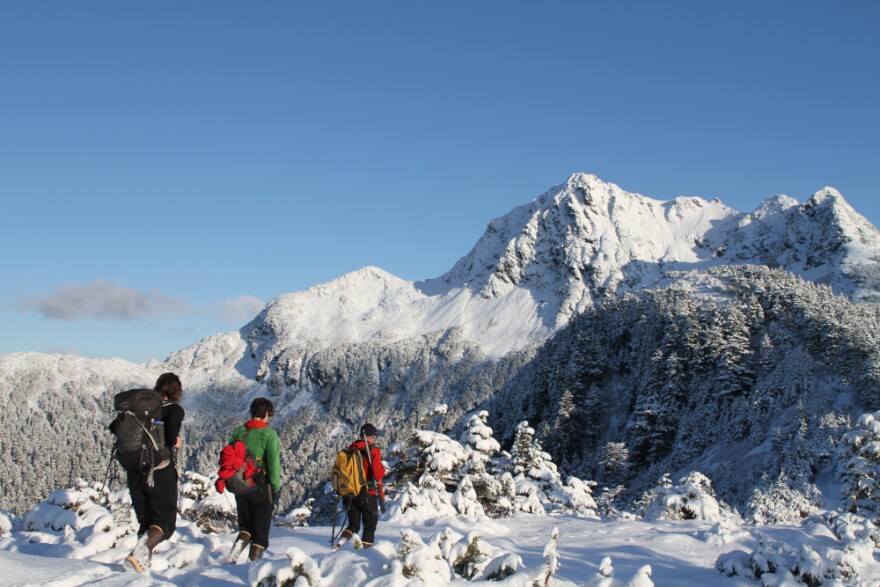The science of forecasting landslides depends on realtime weather data — especially rainfall and wind speed. Until recently in Sitka, that data came from the airport — about as close to sea level as you can get without being in the ocean. This summer a multi-agency team of researchers climbed the mountains above Sitka — where landslides originate — and installed the state’s newest high-elevation weather station. Now, the information it collects is available to the public.
The story of November in Sitka has been a story of rain. But a little way up Harbor Mountain Road, it all turns to snow.
Up Harbor Mountain, Cora Siebert, Geoscience Coordinator at the Sitka Sound Science Center, and Jacquie Foss and Aaron Prussian of the US Forest Service were going to check on the new weather monitor. And to get there, they have to hike — a few miles up the road and the snow gets too deep to drive.
You won’t hear anyone complaining about having to walk today. The sky is cloudless for the first time in recent memory, and bright winter sunlight comes pouring in across the Sound, lighting up the fresh snow. Siebert, with the Science Center, is excited about the information this station is going to produce.
“And this weather is so exciting because it is Sitka’s first high elevation weather monitoring device,” Siebert said. “So we can figure how the rain is different up here from down there and use it to make more accurate forecasts.”
The monitor is part of an effort to better predict landslides after a deadly 2015 slide. It now holds the title of highest elevation weather monitor on Baranof Island, perched on a knoll at about 2,300 feet above sea level.
Collecting data from that high up fills a crucial gap when it comes to understanding landslide conditions. Most local weather information comes from sea level, which is helpful for determining whether you should wear mittens or carry an umbrella. But landslides start up in the mountains. Gabe Wolken, a state geoscientist and professor at the University of Alaska Fairbanks, said this monitor helps researchers get a sense of what’s happening at higher altitudes — a crucial step in developing better prediction models.
“Well the goal of this project is to help develop a warning system for landslides in the Sitka area. And this station really allows us to get one step closer,” Wolken said. “This is really a prerequisite for understanding the conditions that create landslides in that area.”
The information from the monitor will be relayed to the National Weather Service, which could alert local authorities to potential landslide conditions. Siebert said the monitor will benefit Sitka in multiple ways.
“So this is great for landslide research and landslide predicting, it’s also great for our community,” she said. “Just bringing better weather forecasts.”
This landslide monitoring project has brought together a smorgasbord of agencies and organizations, including the Sitka Sound Science Center, the Alaska Division of Geological and Geophysical Surveys, the Sitka Tribe of Alaska, the Rand Corporation, the Forest Service, and the University of Oregon — all of whom are collaborating under a $2.1 million grant from the National Science Foundation.
Sitka’s volunteer Search and Rescue team even got involved in June, lugging 450 pounds of weather station components up the ridge line on a wheeled litter typically used for transporting injured hikers.
Gabe Wolken, the state geoscientist, says this level of collaboration is noteworthy, even before you factor in the search and rescue mission.
“The sort of work we’re doing in Sitka is unprecedented given the number of agencies that are involved and different entities that are interested in helping Sitka find some solutions to these geophysical problems,” Wolken said.
In early November the data became available to the public. Anyone can log on to the website of the Alaska Division of Geological and Geophysical Surveys to check temperature, wind speed and direction, rainfall, and more, all from the comfort of your own home.
Or, if you’re feeling adventurous, you can hike up and check the conditions for yourself. Some distance along the ridge line, the researchers crested a knoll and found the monitor nestled among the snow-covered spruce trees.
It’s a pretty compact apparatus. There’s a small wind sensor spinning away, a rain gauge, a solar panel, and an antenna beaming data down to the Forest Service office.
Stopping for a snack, Siebert found she had enough cell service to check the monitor info online, giving a very precise snapshot of the atmosphere around them.
“The air temperature is -2.348 degrees Celsius,” she read. “The snow depth, in meters, is .139. The rain total, in a fifteen minute sample, in millimeters, is zero.”
In other words, perfect conditions for a snowy, late-November hike.

